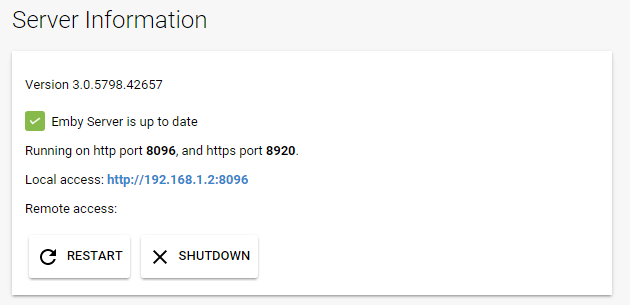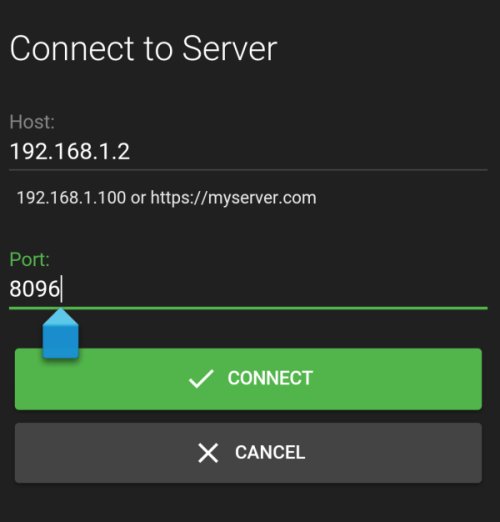Connectivity
This purpose of this document is to discuss how to connect to Emby Server from additional devices, both within your home network and external. To learn how to grant users access to your server, see Users.
In most cases you won't need to do anything to connect to your server from other devices, as Emby apps are built to automatically know how to connect to it. But on some systems some manual configuration might be necessary. This document is primarily designed as for troubleshooting when the automatic features do not work.
In-Network Connections
Most Emby apps can automatically discover your Emby Server on your home network, so in those cases, there's nothing more you need to do. But in the event this does not work, you can still connect to your Emby Server by manually entering the server's address.
To locate your server's internal address, simply open the Emby Server Dashboard on the Emby Server machine, typically http://localhost:8096
Your Emby Server's local address is then displayed in the Local address field.

This information can then be entered into Emby apps:

It is recommended that the local IP Address for the Emby Server machine should be fixed. Use the router's DHCP Reservation feature to do that. Here is a general guide for doing this. https://portforward.com/dhcp-reservation/#how-to-make-a-dhcp-reservation-in-your-router
If you have a VPN running on your router, the requests coming into the server from within the local network may not appear as local and it would be necessary to enable the Network server option "Allow remote connections to this Emby Server". If actual external remote access is not required, then you should ensure that "Enable automatic port mapping" in Server Network settings is unticked and no manual port forwarding is added in the router. The "Allow remote connections to this Emby Server" would also need to be enabled in the Users settings.
Troubleshooting Internal Connections
If the above still does not work, please ensure the machine running Emby Server is turned on, and that the Emby Server application is running.
A useful test is to try to use a web browser on another device, such as another computer, smartphone or tablet. You'll need to ensure the other device is connected to the same WIFI network. Try opening a web browser on that device and entering the local address manually:

If this still does not work, then most likely the firewall on the server machine is not allowing access. Below are a list of troubleshooting steps that can be taken to resolve this.
Open TCP Port 8096 on your server's firewall
If running Windows, most likely you'll need to configure Windows Firewall. See How to open a port in Windows Firewall.
Important: Please do not attempt to skip this step by disabling Windows Firewall, as this usually does more harm than good.
If you're using third party firewall software, you'll need to follow it's instructions to open the port. Note: If you're using third party antivirus software such as Norton Internet Security, it will most likely have it's own firewall that will need to be configured.
Run an AntiVirus Scan
If you're certain you've opened the port and are still unable to connect, the next step will be to ensure the server machine is free of viruses and malware. See AntiVirus software.
External Connections
Emby Server also allows you to connect when away from home. We call these external connections because they're out of our home network. Before we begin, we'll assume everything covered above in the In-Network Connections section is functioning correctly with your Emby Server, and that you're able to connect using other devices in your home network. If not, then you'll want to go over that section first.
The Remote Setup article covers how remote access is enabled and the option for automatic port forwarding using the router's uPnP feature.
Locate Your External Address
Your external address is displayed on the front page of the server dashboard, labeled as Remote access. This is the address you should use when away from home.

Test Your External Address
The easiest way to test your external address, is to open it in a web browser while away from home, or inside your home using a smart phone or tablet with the wifi connection turned off.
Important: Testing your external address inside your home might not work, and this is OK. Some internet routers disable loopback capabilities (going out and coming back in), therefore you might not be able to test this from inside your home network. It's important that you test away from home, or with your smart phone or tablet's wifi connection turned off.
If the external address works in a browser, then you're good to go, and can proceed with connecting from Emby apps.
Setup Port Forwarding
If you're still unable to connect after testing the above, then you may need to setup port forwarding with your router to allow external connectivity to your Emby Server.
To do this, turn off the "Enable automatic port forwarding" option just set and open the web interface for your router. You will need to forward TCP Port 8096 on your router to port 8096 on the Emby Server machine. Do the same for port 8920 as well (if using SSL). It is important that the local IP Address for the Emby Server machine does not change. Use the router's DHCP Reservation feature to do that.
If you want to use different public port numbers, see Network (Hosting) Settings. If you have more than one Emby Server on your local network and the manual port forward method is required, then it will be necessary to change from using the default public port numbers, since each server must have a different public port number.
If you have more than one router, eg an ISP provided router and also your own router, then that would lead to a Double NAT which would lead to failure to reach the server externally. In such cases, it is recommended that one router, e.g. the ISP router, is configured to run in Modem/Bridge mode. If they both need to be running as routers, the configuration would be more complex, needing to cascade the port forward for the public port from the first router to the second and have the actual required port forward on the 2nd router. Also the 2nd router would need to have its local IP Address as a DHCP reservation on the first router.
The process of doing the port forward will be slightly different for each router model. Here are good step by step guides on how to do this:
https://portforward.com/dhcp-reservation/#how-to-make-a-dhcp-reservation-in-your-router http://www.wikihow.com/Set-Up-Port-Forwarding-on-a-Router
This Youtube video also explains it pretty well:
https://www.youtube.com/watch?v=Kp-R-eHiQco
Verify Public Port
To test that your public port is accessible over the internet, try testing it from canyouseeme.org
If this test does not succeed, then it's an indication that your router is blocking the traffic and may need additional configuration.
If the test succeeds but the device is not able to connect to the server externally, check that you have enabled remote connections for the user. See Users.
Remote Access Configuration
Check out the following link for in-depth instructions to set up remote access on Emby Server Remote Setup.
Emby Connect
Regardless of the method used for port forwarding, whether it is automatic using uPnP or a manual configuration of the router, we suggest using the Emby Connect feature as it takes the guesswork out of external connectivity. The Emby apps would find the route to the server using Emby Connect. See Emby Connect.